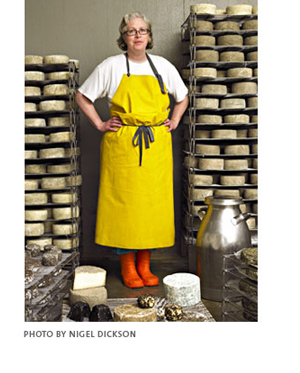Member Profile: Monforte Dairy
Posted: June 29, 2012
Categories: GoodFoodBites / Member Profiles / News from Sustain Ontario
By Stephanie Verkoeyen
Veteran chef Ruth Klahsen always wanted to make cheese. So in 2003 Ruth founded Monforte Dairy, an artisanal dairy specializing in sheep milk cheeses. Six years later, when Monforte found itself without a place to make cheese, rather than pack it in Ruth decided to open her own facility. Lacking sufficient funding, she turned to her loyal customer base and offered Community Shared Agriculture (CSA) subscriptions to raise the capital to build a new dairy. CSA is a cooperative approach to growing and purchasing food products between the farmer and consumer, with both parties benefiting – the farmer wins a guaranteed market, while the consumer gains high quality, fresh food as it becomes available.
specializing in sheep milk cheeses. Six years later, when Monforte found itself without a place to make cheese, rather than pack it in Ruth decided to open her own facility. Lacking sufficient funding, she turned to her loyal customer base and offered Community Shared Agriculture (CSA) subscriptions to raise the capital to build a new dairy. CSA is a cooperative approach to growing and purchasing food products between the farmer and consumer, with both parties benefiting – the farmer wins a guaranteed market, while the consumer gains high quality, fresh food as it becomes available.
Sustainability and impeccable quality are integral to this band of artisanal cheese lovers. Monforte uses only seasonal* milk from humanely treated animals, purchased from 20 different farmers in the area. There are no genetically modified organisms, hormones or antibiotics involved.
Cheese-making is a complex process involving many “subtle complications.” Monforte has over a dozen different varieties of fresh and aged sheep’s, goat’s, and cow’s milk cheeses, including its signature Toscano. Monforte has become supplier of choice to five-star restaurants, leading wineries and progressive food retailers throughout Ontario. All cheesing aside, Monforte is dedicated to giving people the opportunity to have a voice in changing the politics of how quality food is produced, distributed, marketed, and sold.
Cheese-making in a nutshell:
- Acidification: culture is added to milk to change the acidity level and begin solidification
- Coagulation: Rennet is added to further encourage the milk to solidify
- Curds and Whey: Curds are cut, which further encourages them to expel liquid, or whey. Rule of thumb: the smaller the curds, the harder the cheese will be.
- Salting: Salt adds flavour and also acts as a preservative so the cheese does not spoil during the months/years of ageing
- Shaping: The cheese is put into a basket or a mould to form it into a specific shape.
- Ripening: Ageing the cheese until it reaches optimal ripeness; temperature and humidity are closely monitored; ambient moulds in the air, sprayed on/injected moulds, brushed oil, and brine/alcohol washes all give the cheese a distinct flavour.
*Seasonal milk: a cow needs to give birth every year in order to continue producing milk. As well, the amount of milk cows can produce when allowed to graze freely depends on how much grass they have access to, which changes throughout the year.
Ruth Klausen talks about the financial upstart of Monforte Dairy
